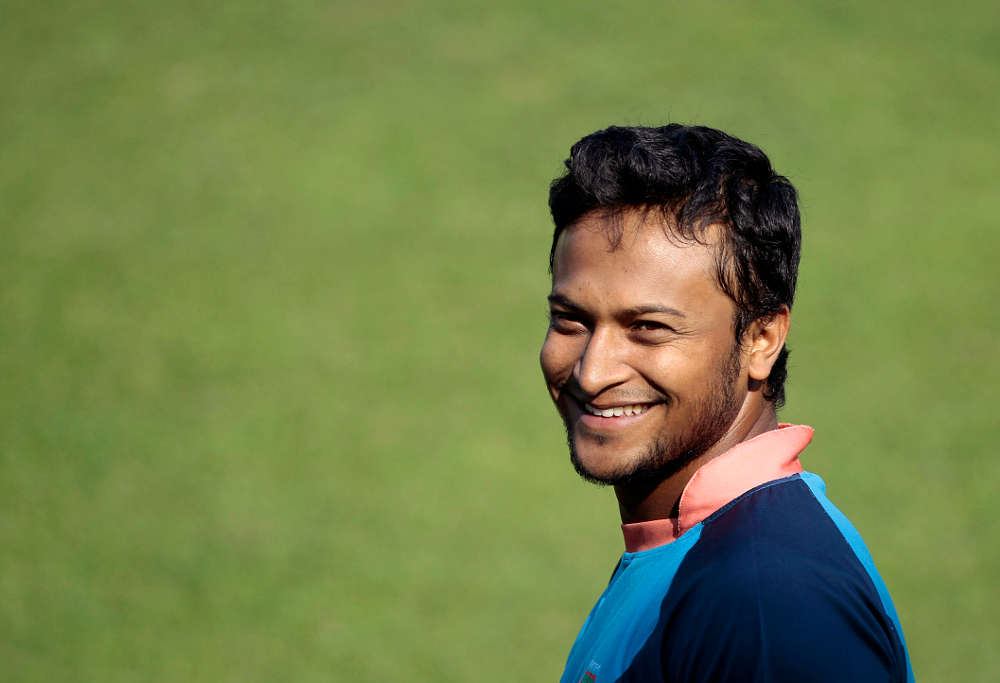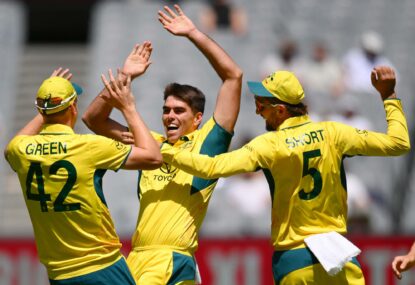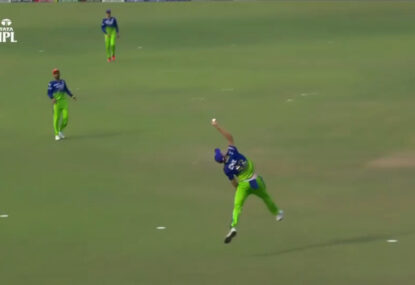The much awaited Test series between the Aussies and the Tigers is set to start at Dhaka on the 27th of this month.
If the weather permits, it could be a very tight Test series and should provide an opportunity for the local team to cause a really huge upset. Obviously, Bangladesh is pinning their hopes mainly on the spin trio of Shakib, Mehedy and Taijul, but it would not be wise to ignore Mustafizur Rahman, the talented left arm seamer.
Ever since his international debut in the summer of 2015, the ‘Fizz’ has made rapid progress as an international star. He remains largely unproven in Test cricket, having played just four matches. But his ODI record shows 44 wickets from 22 matches (Avg. 19.79) and T20 record shows 27 wickets from 17 (Avg. 14.92).
Interestingly, while Mustafiz is easily the most successful left arm seam bowler in our cricket history; he is by no means the only one. In fact, he is carrying a long tradition in our cricket.
One of the most interesting fact about our national cricket team is that it almost always include one or more left arm seam bowler. Our first ODI team included a left arm quickie (Gholam Nousher Prince) and our first Test squad included Bikash Ranjan. In this article, I would be looking at some of the left arm seamers who have represented Bangladesh at different stages in its cricket journey.
The history of international cricket in Bangladesh began in January 1977, with the short tour of MCC, led by Ted Clark. The three-day unofficial Test at Dacca during 9-11 January between Bangladesh and MCC is generally considered the first important international match in Bangladesh’s history.
I would like to mention here that in March 1977, as Australia-England were playing the centenary Test match, Bangladesh was not even an associate member of ICC. The Bangladesh team (led by Shamim Kabir) for the MCC match is generally considered to be the first national cricket team of Bangladesh. And as expected, this team included a left arm seamer, Dipu Roy Chowdhury.
Generally a left arm over the wicket bowler with a slightly round arm action, Dipu, was without doubt, the best Bangladeshi bowler of his type in the late 1970s. And he was a regular with the national team until 1984.In the process he represented Bangladesh in two ICC trophy events.
In the MCC match, Dipu shared the new ball with (Late) Daulatuzzaman; and the pair did a good job in the only MCC innings of the match. Nazrul Quader, a left arm spinner, bowled superbly to take 4/54; but he got excellent support from the seamers, Daulat 3/67, and Dipu 2/92.
Later, Dipu mostly shared the new ball with Jahangir Shah Badshah, the best Bangladeshi all rounder of his time. And in his final international match for Bangladesh, against HK in January 1984, Dipu impressed everybody taking 3/17. With Badshah taking 3/29, the HK side was restricted to 151 all out (45 over match). Bangladesh won by three wickets and thus qualified for the second Asia cup In SL in 1986.

(Photo by Martin Hunter/Getty Images)
Apart from his bowling skills, Dipu often excelled in late order batting. Basically, a left handed hard hitting batsman like Wasim Akram, he often scored vital runs for his team down the order. His batting was especially suited to the limited over game.
Gholam Nousher, better known as Prince, was the man who replaced Dipu as our premier left arm seamer. Originally from Mymensingh, Prince joined the Dhaka league in the early 1980’s. He soon impressed with his pace, In fact, he was the fastest bowler in Bangladesh throughout the 80’s.
During the first SEA cricket tournament in Bangladesh, in January 1984, Prince was selected to play for the second string team, called the Bangladesh Tigers. (It is important to note that during the early days of our cricket history, ‘The Bangladesh Tigers’ was generally used to mean the youth or the second string team).
Prince didn’t take many wickets in the event; but throughout the tournament he bowled accurately making run making against him extremely difficult.
He graduated to the main national team in 1985. In his debut match against SL, he got the big scalp of Ranjan Madugalle. Even more impressive was his display against the Pak team (led by Imran Khan) in January 1986.
The three day match started on the New Year’s Day. The weather was unusually heavy for winter, and as the tourists batted first, they found batting difficult with the ball moving in the air. Prince bowled accurately in the morning but went unrewarded. But, he came back brilliantly after lunch taking the wickets of Shoaib Mohammad and Ramiz Raja; both established Test players.
While his natural delivery left the right handers; here he managed to get odd deliveries back into the right handers. The only criticism perhaps can be that in swing friendly conditions his length was just a bit short. Badshah, the old pro, bowling form the other (Paltan) end kept the ball up to get great success.
Despite frequent injuries, Prince remained a regular with the national team until the mid 90s. He represented Bangladesh in seven ODIs and three ICC trophy events. He disappointed in 1986, bowling too short for English conditions. But, he had an outstanding time in the next event, Holland 1990.
He was the top wicket-taker for his side with 13 scalps at less than 20 each. Throughout the tournament, Prince and Jahangir Alam Dulu (another left armer) made early breakthroughs with the new ball, giving the chance for the spinners to have a go at the middle order.
Sadly, his best effort, 3/47 against Zimbabwe went in vain; as Dave Houghton’s fighting 91* took the favourites to the finals.
Prince started the 1994 event well, taking eight wickets (at 14.125) in the 4 first round group matches.
After years of toiling hard on the flat tracks of the subcontinent, he was fully enjoying the extra pace and bounce of the Nairobi wickets. Sadly, he injured himself in the middle of the event; and flew back home. His presence was badly missed in the crunch second round fixture against the hosts Kenya.
Back to the 1980s, the 1984 Tigers’ team included two other left armers. Golam Morshed, from Chittagong, shared the new ball with Prince during the tournament; and like Prince, kept the opposition batsmen quiet.
He never had the pace to become an international class bowler, but he remained a consistent performer in the domestic arena for more than a decade. Abul Khaier Mohon was quicker; but more erratic as well. Still, he produced a MoM effort against Singapore at Chittagong. First with the bat he scored a quick-fire 28 and then took 2/14 from seven overs.
Jahangir Alam Talukdar Dulu first came in to prominence during the 1985-86 season with a string of impressive performances for Bangladesh Biman. He had a round arm action, just like Dipu.
Nevertheless, he had the ability to get good bounce from the short pitch deliveries. The selectors picked him for the match against Imran Khan’s team; but he disappointed. Coming first change, he bowled too short, giving away some easy runs square of the wicket.
He came back to the national team in 1989-90. And during the ICC trophy in the following summer, he did an outstanding job with the new ball.
He took only nine wickets; but his economy rate (3.53) was very impressive. Less impressive was his effort in Kenya in 1994; and he lost his place in the team as the Tigers started rebuilding after the Kenya fiasco.
Anisur Rahman enjoyed a highly successful time with the Bangladesh U-19 team in Asian youth cup in December 1989. At Mymensimgh, he took 3/44 against India. Even more impressive was his 3/35 against Pakistan at Dhaka; after removing the openers cheaply he came back in the slog overs to pick up the big scalp of Moin Khan.
Yet, Anisur Rahman would find it difficult to get himself in to the main national team. Of course, two other left armers, Prince and Dulu were in the team already. Also, no ball problems combined with injuries hampered Anisur’s progress. Still, following the retirement of Prince and Dulu in 1994, Anis became our main left arm seamer.
He bowled brilliantly in the second SAARC cricket tournament in December 1994. With 11 wickets (at 12.00) from four matches he emerged as the highest wicket taker in the event. His best 4/29, came against SL ‘A’. One of his four victims was SL ‘A’ captain Chandika Hathurasingha, the current Tigers coach.
The reverse swing with the old ball was Anisur’s big weapon. In fact, he was the first Bangladeshi bowler to use this technique successfully.
Anisur played two ODIs for Bangladesh, both against India. He failed to impress with Sachin Tendulkar deciding to go after him on both occasions.
Like his former teammate, Enamul Haque Moni, Anisur Rahman is now a very distinguished international umpire.
Md. Rafiq is an interesting case. Despite his short built he always wanted to be a fast bowler; and indeed during the 1992-93 season he enjoyed a highly successful time with the Bangladesh Biman team. But, encouraged by Biman’s Pak all-rounder Wasim Haider (a member of the 1992 World Cup wining team), he took left arm spin and within two years became country’s leading slow bowler.
He was one of the few Bangladeshi cricketers who made a successful transition from Associate level cricket to Test match cricket. He became the first Bangladeshi to do the Test double, 1000 runs and 100 wickets.
Bikash Ranjan Das had the honor of representing Bangladesh in their maiden Test. But after taking 1/64 and 0/8, he lost his place. Indian opener Sadagopan Ramesh is his only Test victim.
Manjurul Islam, replacing Bikash, made a memorable Test debut against Zimbabwe in April 2001. At Bulawayo, he took 6 for 81. Yet, wickets died out for him after that and he finished with only 28 victims form 17 Tests.
He also struggled in the 34 ODIs that he played for Bangladesh. Like many others of his generation, he found the transformation from associate member level cricket to the highest level a bit too tough.
Then came a slightly dull period for our left arm seamers. Still, Syed Rasel carried the tradition with six Tests and 52 ODIs. He lacked the pace required to trouble top order batsmen in Test matches; but his accuracy made him more successful in ODI format. His best effort, 4/22 came against Kenya in august 2006.
The daddies of them all. I started this article with Mustafizz and it’s highly appropriate that I finish with him. Over the last two and a half years the young man from Satkhira, in South-West Bangladesh, has become a household name not only in Bangladesh, but in abroad as well. While, his ODI and T-20 records are highly impressive, he is yet to make his mark in Test cricket.

(AP Photo/A.M. Ahad, file)
I feel there is scope for improvement in his bowling. Obviously, his bowling has been analyzed heavily by the opponents. While his off cutter remains a lethal weapon, he needs to add variation in his bowling. He had a disappointing time in England in June, unable to get any swing.
But the biggest concern is his fitness. Like Prince and Anis before him, he is highly injury prone. Already, the Bangladesh team management is trying to make sure that he doesn’t get overloaded. Interestingly, during the IPL 2016, it was said initially that due to his injury problems, he would play only a few matches, sharing his duties with the Kiwi left armer Travis Boult.
As things happened, ‘The Fizz’ played almost all the matches; with Boult only making a few cameo appearances.
The Bangladesh coach wants Mustafiz to have a full season in the county cricket. He reckons this would help greatly in his development as a match winning Test bowler.
Sajedul Islam and Abu Hider are two other prominent left arm seamers in domestic cricket. But they mostly remain in the fringes of international cricket.







































































































